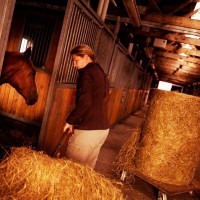Reduced intestinal motility when stabling horses after pasture

Management regimes have been shown to impact horse health, for example stabled horses have an increased risk for colic. Here we summarize two studies investigating the causes of this. Horses’ intestinal motility was measured when they were pastured (and were not exercised) and when the horses were stabled and performed light exercise daily. At pasture horses can move freely day and night, eat during many hours and pasture usually contains considerably more water than other feeds. In addition concentrate feeds imply an increased risk of colic.
When the horses were stabled and had had a two-week adaptation period to the stalls and daily light exercise their intestinal motility was measured using ultrasonography and compared to measurements from the pasture period. The contractions were measured at three areas along the large intestine where problems usually arise. Stabling resulted in fewer contractions than when the horses were pastured, see table 1.
Reasons to why intestinal motility decreases when horses are stabled can be more time spent standing still, different feed, less volume of feed and drier feed. The table below show how much horses drank, how much faeces they excreted and the DM concentration of the faeces when they were pastured and the first two weeks of stabling (Table 2). When the horses were stabled they did 60 min of daily light exercise.
Table 2 show that the horses drank considerably more when they were stabled than when they were pastured. Pasture contains a lot more water than dry feeds and therefore horses need to drink more when they are stabled. Despite that the horses drank more they still had considerably drier faeces when stabled which indicates that they did not manage to completely compensate the water intake by drinking more. Since horses have to drink more when they eat dry feeds the water supply method becomes very important. When horses cannot maintain normal fluid balance water is absorbed from the hindgut to compensate and protect the intravascular volume, which implies increased risk for impaction and colic. If your horse has very dry faeces it might be a good idea to check the water supply method and how it is working. Read more about water supply method and horses’ water intake here.
In addition the amount of faeces excreted was less when horses were stabled, this shows how a limited feed ration gives less faeces in comparison with the free access at pasture. This implies less volume of intestinal content and drier intestinal content which can have an impact on horses’ intestinal motility.
To summarize stabling implicated impact on the horses’ possibility to move freely and they had to drink more but still had drier faeces and excreted less faeces. To decrease the risks for intestinal disturbances and colic we need to evaluate and develop our management regimes.
Sara Muhonen, AgrD


